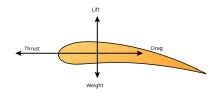Aerodynamic force

Aerodynamic force is exerted on a body by the air (or some other gas) in which the body is immersed, and is due to the relative motion between the body and the gas. Aerodynamic force arises from two causes: [1][2][3]
- the normal force due to the pressure on the surface of the body
- the shear force due to the viscosity of the gas, also known as skin friction.
Pressure acts locally, normal to the surface, and shear force acts locally, parallel to the surface. The net aerodynamic force over the body is due to the pressure and shear forces integrated over the total exposed area of the body.[4]
When an airfoil (or a wing) is moving relative to the air it generates an aerodynamic force, in a rearward direction at an angle with the direction of relative motion. This aerodynamic force is commonly resolved into two components:[5][6]
- drag is the force component parallel to the direction of relative motion,
- lift is the force component perpendicular to the direction of relative motion.
In addition to these two forces, the body may experience an aerodynamic moment also, the value of which depends on the point chosen for calculation.
The force created by a propeller or a jet engine is called thrust and it is also an aerodynamic force (since it also acts on the surrounding air). The aerodynamic force on a powered airplane is commonly represented by three vectors: thrust, lift and drag.[7][8]
The other force acting on an aircraft during flight is its weight. Weight is a body force and is not an aerodynamic force.
See also
Notes
- ^ Hurt, H.H.Jr. Aerodynamics for Naval Aviators. p.29
- ^ Clancy, L.J. Aerodynamics. Section 4.10
- ^ Massey, B.S. Mechanics of Fluids, section 10.8.2
- ^ Anderson,J.D.Jr Aircraft performance and design. Section 2.2
- ^ Hurt, H.H.Jr. Aerodynamics for Naval Aviators. p.14
- ^ Clancy, L.J. Aerodynamics. Section 5.3
- ^ Hurt, H.H.Jr. Aerodynamics for Naval Aviators. Fig 2.20
- ^ Clancy, L.J. Aerodynamics. Section 14.2
References
- Hurt, H.H.Jr. Aerodynamics for Naval Aviators. A National Flightshop Reprint, Clearwater, Florida (1979)
- Clancy, L.J. (1975). Aerodynamics. Pitman Publishing Limited, London. ISBN 0-273-01120-0
- Massey, B.S. Mechanics of Fluids, 2nd Edition. Van Nostrand Reinhold Co., London (1970) Library of Congress Catalog Card No. 67-25005
- Anderson, J.D.Jr. Aircraft performance and designTata McGraw-Hill. ISBN 978-0-07-070245-5
